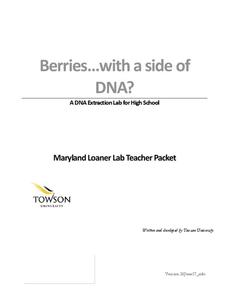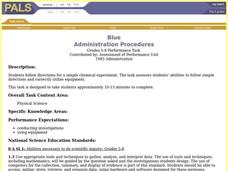Teach Engineering
Storing Android Accelerometer Data: App Design
There's an app for that! Pupils learn to build an app that will store data on an Android. The instructional activity introduces class members to the tiny database, TinyDB, for Android devices. A video tutorial provides an example that...
Concord Consortium
Polymers and Monomers
You don't want to break these chains! Show young chemists and biologists the basics of polymerization with a simple interactive. The resource gives learners three types of polymers to experiment with, as well as a brief tutorial about...
Nuffield Foundation
Digestion of Starch: Microbes
Sugar isn't good for you, but it's great for microbes. A simple experiment has pupils investigate the digestion of starch by microbes to produce sugars. They apply two bacterial cultures, an amylase solution, and distilled water on a...
Curated OER
Creating a Simple Telegraph Machine
Students experiment and discuss circuits and how they work. In this science lesson, students construct a telegraph machine using cardboard, wires, battery, electric tape and masking tape. They investigate what happens as the circuits...
Curated OER
A Teeth Changing Experience
Students research human health by reading an educational story in class. In this oral health lesson, students identify the importance of brushing their teeth and consuming calcium. Students read the book A Teeth Changing Experience and...
Curated OER
The Science of Sound and Musical Instruments
Students identify the components of sound. They describe the relationship between pitch and frequency and explain the terms sympathetic vibrations and resonance.
They perform simple experiments about the world of sound and explain the...
Curated OER
What is a Class One Lever?
Fifth graders understand what a lever is, how it works and what the parts of a lever are. For this first class lever lesson, 5th graders label pictures and design a lab lever. Students predict the outcome of experiments with their lever...
Curated OER
Investigation: Evaporation
An evaporation investigation! This collection of slides walks future scientists through the process of setting up an experiment on how to speed up evaporation. The experiment is simple enough to use at the beginning of the school year to...
Curated OER
Cnidarian Reproduction and Platyhelminthes
Opening with one slide on cnidarian reproduction, this PowerPoint is more focused on phylum platyhelminthes. It touches on flatworm structure, feeding, body systems, and reproduction. Simple, yet informative, this resource will support...
Foundation for Water & Energy Education
How is Flowing Water an Energy Source? Activity A
Here is a fun little exploration of the potential energy potential of falling water. Learners drop water from various heights using a straw, and they analyze the diameter of the splash. Pair this with two more activities of the same...
Baylor College
Greenhouse S'Mores
Your class will agree that this is the best way to demonstrate the greenhouse effect: making solar s'mores! Using a clear plastic cups as mini atmospheres, lab groups compare how adding different materials affects the melting rate of...
NOAA
Importance of Deep-Sea Ecosystems – What Killed the Seeds?
Most drugs used today come from nature, so the discovery of new ecosystems in the deep sea is exciting from a medical perspective. Scholars develop their own bioassay to test germination rates in seeds.
American Chemical Society
Why Does Water Dissolve Salt?
Individuals explore solubility by modeling how water dissolves salts. They then view a video and compare how well water and alcohol dissolve salts, relating their comparisons to the structure of each molecule.
Towson University
Berries...With a Side of DNA? (High School)
Is DNA still present after picking fruit or cooking vegetables? Biology scholars extract and collect DNA strands in an impactful lab. Working groups prepare their samples and compare their results to negative and positive standard...
Curated OER
Blue
Students follow directions for a simple chemical experiment. They use the appropriate tools and techniques to gather, analyze, and interpret data. Students identify a substance that has characteristic properties, such as density, a...
Curated OER
Using Inspiration To Support Logical Reasoning
Students share descriptions of science experiments they have conducted. They create a thin film on the surface of water in order to float light objects and observe that a paper clip does, indeed, float on the surface of the water at...
Curated OER
Simple Harmonic Motion with Dr. DAQ
Young scholars study the work and accomplishment of Galileo. In this physics lesson, students calculate the period of a pendulum's using a mathematical equation. They explain the different factors affecting its period.
Curated OER
Homopolar Motor Experiments
Learners construct a homopolar motor following certain procedures. In this physics lesson, students explain how generators and motors work. They compare and contrast the characteristics of both.
Curated OER
Science As Inquiry
Students practice problem solving through the inquiry approach. They are divided into small groups and given various problems to folve regarding the germination of radish seeds.
Curated OER
Casual Patterns in Simple Circuits
Students work in cooperative pairs to create a series circuit and a parallel circuit. Students compare and contrast the two different types of circuits using worksheets that are included.
Curated OER
Earth Energy Budget Pre Lab
Learners explore energy by conducting an in class experiment. In this climate change lesson, students conduct a water vapor experiment in a soda bottle. Learners utilize graphs and charts to analyze the results of the experiment and help...
Curated OER
A Very Simple Conductivity Meter
Students investigate the hardness of different water samples using the conductivity meter. In this chemistry instructional activity, students build their own meter following specific procedures. They identify an unknown sample of water.
Curated OER
What Is the Nature of Science?
Students distinguish between scientific and everyday meanings of key words-theory, hypothesis, law, fact-and use in context. They recognize the variables that affect observation, data collection, and interpretation. They discover the...

























